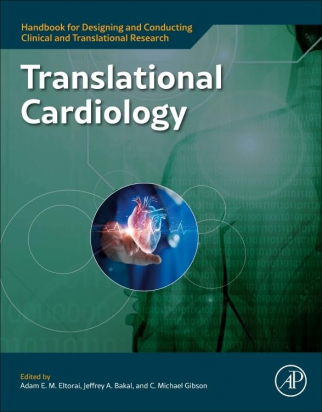Non ci sono recensioni
DA SCONTARE
| Translational Cardiology provides a cardiology-specific instructional guide to translational medical research that will serve as a practical, step-by-step roadmap for taking a biomedical device, potential therapeutic agent, or research question from idea through demonstrated clinical benefit. Fundamentally, the volume aims to help bridge the gap between current research and practice. Written by a team of expert medical, biomedical engineering, and clinical research experts in cardiology, this book provides a clear process for understanding, designing, executing, and analyzing clinical and translational research. |
| Features: |
|
Section 1. INTRODUCTION
1. Introduction; 2. Translational Process; 3. Scientific Method; 4. Basic Research
Section 2: PRE-CLINCIAL: DISCOVERY & DEVELOPMENT
5. Overview of Preclinical Research; 6. What problem are you Solving?; 7. Types of Structural Interventions; 8. Drug discovery; 9. Drug Testing; 10. Device Testing; 11. Diagnostic Discovery; 12. Diagnostic Testing; 13. Other product types; 14. Procedural Technique Development; 15. Behavioral Intervention
Section 3: CLINICAL: FUNDAMENTALS
16. Introduction to clinical research: What is it? Why is it needed?; 17. The question: Types of research questions and how to develop them; 18. Study population: Who and why them?; 19. Outcome measurements: What data is being collected and why?; 20. Optimizing the Question: Balancing Significance and Feasibility
Section 4: STATISTICAL PRINCIPLES
21. Common issues in analysis; 22. Basic statistical principles; 23. Distributions; 24. Hypotheses and error types; 25. Power; 26. Regression; 27. Continuous Variable Analyses: Student's t-test, Mann-Whitney U Test, Wilcoxon Signed-Rank Test; 28. Categorical variable analyses: Chi-square, fisher exact, Mantel hanzel; 29. Analysis of variance; 30. Correlation; 31. Biases; 32. Basic science statistics; 33. Sample Size; 34. Statistical Software
Section 5: CLINICAL: STUDY TYPES
35. Design principles: Hierarchy of study types; 36. Case series: Design, measures, classic example; 37. Case-control study: Design, measures, classic example; 38. Cohort study: Design, measures, classic example; 39. Cross-section study: Design, measures, classic example; 40. Longitudinal Study: Design, Measures, Classic Example; 41. Meta-analysis: Design, measures, classic example; 42. Cost-effectiveness study: Design, measures, classic example; 43. Diagnostic test evaluation: Design, measures, classic example; 44. Reliability study: Design, measures, classic example; 45. Database studies: Design, measures, classic example; 46. Surveys and questionnaires: Design, measures, classic example; 47. Qualitative methods and mixed methods
Section 6: CLINICAL TRIALS
48. Randomized control: Design, measures, classic example; 49. Nonrandomized control: Design, measures, classic example; 50. Historical control: Design, measures, classic example; 51. Cross-over: Design, measures, classic example; 52. Withdrawal studies: Design, measures, classic example; 53. Factorial design: Design, measures, classic example; 54. Group allocation: Design, measures, classic example; 55. Hybrid design: Design, measures, classic example; 56. Large, pragmatic: Design, measures, classic example; 57. Equivalence and noninferiority: Design, measures, classic example; 58. Adaptive: Design, measures, classic example; 59. Blinding: Who and how?; 60. Phases of Clinical Trials; 61. IDEAL Framework
Section 7: CLINICAL: PREPARATION
62. Patient Perspectives; 63. Budgeting; 64. Ethics and review boards; 65. Regulatory considerations for new drugs and devices; 66. Funding approaches; 67. Conflicts of Interest; 68. Subject recruitment; 69. Data management; 70. Quality control; 71. Research in Acute Settings; 72. Special Populations; 73. Report forms: Harm and Quality of Life; 74. Subject adherence; 75. Survival analysis; 76. Monitoring committee in clinical trials
Section 8: REGULATORY BASICS
77. FDA overview; 78. IND/New Drug Application; 79. Radiation-Emitting Electronic Products; 80. Orphan Drugs; 81. Combination Products; 82. CMC and GxP; 83. Non-US Regulatory; 84. Post-Market Drug Safety Monitoring; 85. Post-Market Device Safety Monitoring
Section 9: CLINICAL IMPLEMENTATION
86. Implementation Research; 87. Design and Analysis; 88. Mixed-Methods Research; 89. Population- and Setting-Specific Implementation; 90. Guideline Development
Section 10: PUBLIC HEALTH
91. Public Health; 92. Epidemiology; 93. Factors; 94. Good Questions; 95. Population- and Environmental-Specific Considerations; 96. Law, Policy, and Ethics; 97. Healthcare Institutions and Systems; 98. Public Health Institutions and Systems
Section 11: PRACTICAL RESOURCES
99. Presenting Data; 100. Manuscript Preparation; 101. Promoting Research; 102. Quality Improvement; 103. Team Science and Building a Team; 104. Patent Basics; 105. SBIR/STTR





